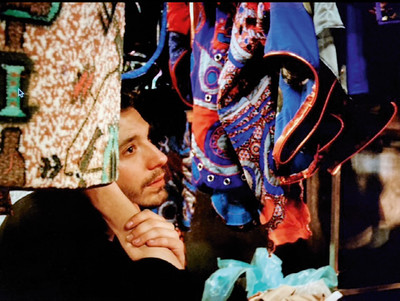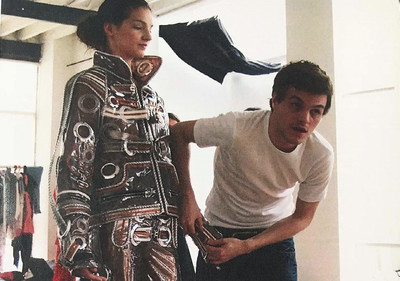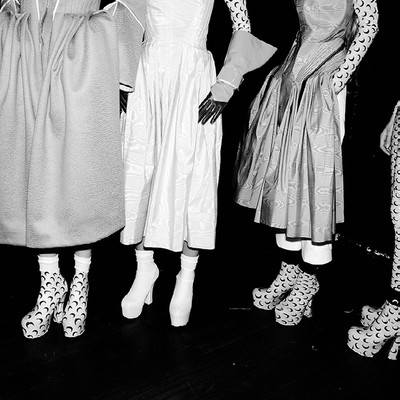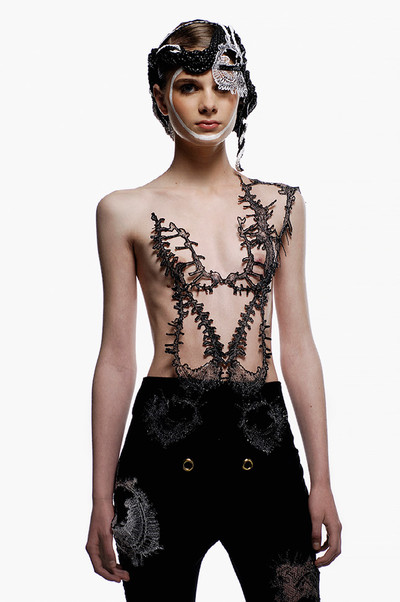System invited five current La Cambre Mode[s] students to submit questions to their school’s alumni designers.
System invited five current La Cambre Mode[s] students to submit questions to their school’s alumni designers.

Julien Dossena as a student at La Cambre.
Julien Dossena
creative director,
Paco Rabanne
What is your best memory of being a student at La Cambre?
There are so many, but most are based on the friendships we built at that particular time. Emulation and solidarity in work are two of the strongest values that I experienced at La Cambre. Even today, some of my closest friends are former classmates.
How did you experience the transition from student to successful designer at a big company such as Paco Rabanne? How do you balance your creativity and the industrial-production processes?
I remember when I was a student, all my willpower was focused on this one goal of working in an ultra-inspiring studio. It was really stressful anticipating this move, but in the end all you really have to manage is the change of scale. There’s more responsibility, of course, but in the day-to-day creative process, it is the same gestures and exploratory techniques. The industrial process can sometimes be destabilising, but you learn with experience – until it’s integrated into your relationship with creativity – that this balance is always present in the creative gesture.
Does the foundation of creative DNA that you forged at school still exist in your work?
You learn to express it for the first time at La Cambre and you’re invited to draw on it, but really it’s just a catalyst for what you’ve been carrying as aesthetic sensations almost since childhood.
How does it feel using your creativity in the service of a house? Have you found the right space in which to express yourself? Or do you prefer being independent with your own label?
Having experienced both, it’s a very different exercise: one is about creating a total universe that you make exist both visually and in the market; the other is at the service of a house’s aesthetics and the research into a pre-existing universe that must be perpetuated and respected. Whichever choice you make, both possibilities will ultimately call for the same commitment and the same problem solving whether it’s your name or the house’s on the label; it’s about knowing how to make your proposals resonate in a modern way.
La Cambre Mode[s], because of its position as part of an art school, defends meaningful fashion with aesthetic values that question the contemporary world. Does this philosophy remain at the heart of your concerns despite commercial pressures?
Of course, and even more so, when taking these commercial pressures into account. This is really the exact space where the philosophy of La Cambre will be crystallized, and above all where it will be brought to life in the street. The value that I remember most being taught at La Cambre is the principle of sincerity, of integrity in terms of self-expression. The teachers always pushed us to work on what really moved us personally, an idea of auteur fashion, if you can compare it to cinema, for example. I still keep this in mind when I work on a collection today.
The school is also well-known for the huge amount of work you have to do as a student. What advice would you give someone at the school today?
It’s great preparation for the endurance and hard work that this job requires. The amount of work may seem difficult at the beginning but it quickly becomes a necessary discipline. This is one of the great strengths of La Cambre students, which quickly manifests itself in the studios and ateliers. So, to the students: hang on in there and you will be prepared for all eventualities.
After all these years, do you still consider yourself as part of La Cambre?
Of course, in my domain, La Cambre is still perceived as a guarantee of quality and high standards. It remains the place where the teachers accompanied me and taught me to forge the aesthetic that is still mine today.

Matthieu Blazy fitting one of his student collections at La Cambre.
Matthieu Blazy
creative director,
Bottega Veneta
What is your best memory of being a student at La Cambre?
My first few months as a student are some of my best memories at La Cambre. I was 18 and had just arrived in Brussels. The mornings at the Marolles neighbourhood flea market, the cheap beer, my gang of friends, the parties – and most of all, that feeling of total freedom.
How did you experience the transition from student to successful designer at the head of a big company? How do you balance your creativity and the industrial-production processes?
You have to know how to value time; I’ve evolved step by step. During my studies, I did an internship at Balenciaga, then at John Galliano, but it was really with my first job at Raf Simons that I learned how to combine creativity with the production process.
Does the foundation of creative DNA that you forged at school still exist in your work?
Yes, the foundations are still there. At La Cambre, you’re encouraged to be curious about everything, without barriers or hierarchies, to understand creation in all its forms. Whether it’s through the study of fashion, design, art or architecture. I made a coat inspired by Laika, the first dog in space, which not everyone understood, but they let me do it. I still take the same approach in my creative process.
How does it feel using your creativity in the service of a house? Have you found the right space to express yourself?
You have to be intellectually and creatively honest, take risks, but also enjoy yourself. I’m lucky at Bottega Veneta to be surrounded by great teams that give me a lot of support.
La Cambre Mode[s], because of its position as part of an art school, defends meaningful fashion with aesthetic values that question the contemporary world. Does this philosophy remain at the heart of your concerns despite commercial pressures?
Yes, absolutely. We don’t just make clothes for the runway; each collection is meaningful by questioning and being inspired by the world around us.
The school is also well-known for the huge amount of work you have to do as a student. What advice would you give someone at the school today?
Work is healthy! But so are friends…
After all these years, do you still consider yourself as part of La Cambre?
Yes, the training at La Cambre goes beyond the fashion world, which gives a certain freedom and allows a more experimental, occasionally more absurd, approach to clothing and design.

Looks from Marine Serre’s MA graduation collection, RADICAL CALL FOR LOVE, 2016.
Photograph: Michael Marson.
Marine Serre
founder and creative director,
Marine Serre
What is your best memory of being a student at La Cambre?
I’d say that my best memory was the RADICAL CALL FOR LOVE show, which was my last at La Cambre. It was an emotional moment for me and the culmination of a search for meaning that had taken five years.
How did you experience the transition from student to successful designer at the head of your own label? How do you balance your creativity and the industrial-production processes?
The transition was immediate and radical, given that I launched my house just a few months after the La Cambre show. It was a moment of great joy because it was the first time my work had been seen outside the school. As far as the industrial aspect of production is concerned, our Regenerate process, which involves upcycling, deadstock, innovative recycled materials, is the foundation of the house. It was very complicated to set up, given its innovative nature in the industry, but it’s the reason we’ve been able to use a radical industrialization approach for six years now. With the DNA of the house centred around upcycling, I can stay true to my values. I’ve used my creativity to transform the production process.
Does the foundation of creative DNA that you forged at school still exist in your work?
Yes, as I said, the Regenerate process is the guarantee of this. My RADICAL CALL FOR LOVE collection was the beginning, through its sociopolitical questioning and through the design and production process. It was a kind of manifesto for all the collections that followed.
Does having your own label give you the right space in which to express yourself?
It was important for me to remain independent to stay free. It was also important because it’s the only way to make sure that my values are respected and that commercial interests don’t take over. Deciding to be independent takes a lot of work, perseverance, and perhaps a sort of optimism, too. Today, after six years, I feel like I’ve brought together a real community, not only within the company because now we’re nearly 100, but also through the artists, activists, and creative people with whom we work, as well as all those who feel connected to our company.
La Cambre Mode[s], because of its position as part of an art school, defends meaningful fashion with aesthetic values that question the contemporary world. Does this philosophy remain at the heart of your concerns, despite commercial pressures?
Yes, completely. For me, it’s vital to question the world we live in and to give meaning to an industry that’s disconnected from the environment. I think that’s why La Cambre suited me so well; it gave me an education that went beyond fashion design and taught me how to question the world.
The school is also well-known for the huge amount of work you have to do as a student. What advice would you give someone at the school today?
It’s true – there was a lot of work at La Cambre, but it’s the ideal place to learn rigour and believe me my days are fuller now. Beyond the workload, it’s a place so full of passion, fun and freedom, and it really allows for personal and creative research.
After all these years, do you still consider yourself as part of La Cambre?
Yes, especially because I’m still really in touch with both the people I studied with and the teachers. I also loved my experience in Brussels; it’s a city I have a really special bond with.

A look from Anthony Vaccarello’s fifth-year MA collection, 2006.
Photograph: Emmanuel Laurent. Model: Helen Feskens.
Anthony Vaccarello
artistic director,
Saint Laurent
What is your favourite memory as a student at La Cambre?
When I passed the entrance exam! I’d been doing fine arts and had been so busy having fun that I’d failed the year. I hadn’t told my parents, though, so when I took the entrance exam for La Cambre I was like, ‘Shit, if I fail this entry exam, I really am screwed because then I’ll have to tell them I failed the fine-arts year.’ I really focused on the exam and was so, so happy when I got in. Out of about 100 people taking the exam, only 20 of us were selected.
How did you experience the transition from student to successful designer at the head of a big company?
It didn’t happen straight away. When I finished La Cambre in 2006, I went to Fendi, working with Karl, for two years. My own brand took ten years to establish. I quickly realized that coming from La Cambre you’re not at all prepared for the whole production and merchandising side of fashion – the commercial system – about which we had absolutely zero lessons at that time. There was none of that at La Cambre, which I personally think is quite good, because we were encouraged to focus on far more artistic things from deep inside of us, which we ourselves were left to articulate. You end up discovering the commercial side of fashion while on the job, which makes more sense. One of the problems with French fashion schools is this overly product- and business-based approach, which results in everyone doing the same thing and becoming very commercial.
Does the foundation of creative DNA that you forged at La Cambre still exist in your work?
I think so. Back then it was the ‘Bernhard Willhelm era’ – everything a bit mad. That was the complete opposite of what I was doing at the time, which was way more Tom Ford. So I was seen as the Italo-sexy-Belgian – a bit of an anomaly, given where and when this was – but I didn’t care. That’s something that I have very much kept today.
How does it feel using your creativity to serve another house? Have you found the right space to express yourself within this house?
Working for Saint Laurent, I don’t ever say to myself, ‘I’m giving my creativity to someone else’. It is me through the DNA of Saint Laurent, an encounter between us that makes me do what I do. There isn’t any frustration – this isn’t my brand. I have sort of carte blanche anyway here, so I am very satisfied.
La Cambre Mode[s], because of its position as part of an art school, defends meaningful fashion with aesthetic values that question the contemporary world. Does this philosophy remain at the heart of your concerns?
I had the choice between La Cambre or going to Antwerp, which I had always thought was more about costume and theatre, less real. So I chose La Cambre for its more contemporary, clothing-based, wearable approach to fashion. That aspect of doing things that we can actually wear and that make sense today has always interested me. That’s why I love this job [at Saint Laurent] – every six months we question what we’re wearing today, so we don’t go off-track. Does it make sense in terms of what we said six months ago, and what is happening around us, culturally?
The school is also well-known for the huge amount of work you have to do as a student. What advice would you give someone at the school today?
Things have changed slightly. I was on the jury this year, and the professors said that these days, young people want more of a life beyond fashion – they want a lover; they want a dog. It’s so alien to me, because my generation – along with Matthieu [Blazy], Nicolas [Di Felice] and all of us – was so entirely focused on what we were doing at school. I didn’t have any sort of life outside of it. I put everything else on hold for five years because I really wanted it. I adored it; I had so much fun. I loved the submissions when we were torn apart by the teachers. They were so mean, but I loved it! That’s what enabled us to make progress; I never took the criticism badly. When you go to La Cambre or want to do this kind of job, it’s like a religion; it’s all or nothing. The other thing I noticed is that back in my day there were several very strong and different characters among the students, which meant that very different collections were created. You knew just from looking who had designed those different collections. It was apparent; it was so individualist.
After all these years, do you still consider yourself as part of La Cambre?
Yes, because those five years of training at La Cambre were so hard, they created a kind of affiliation. We feel like we are part of a group. Even if we don’t see each other every day, I still speak to Matthieu and Nicolas. La Cambre really brought us together; you can see it in the way we work. We really acknowledge each other’s work, and are united by that.
![Future systems. La Cambre Mode[s] Part 2 - © System Magazine](https://system-magazine.com/media/pages/issues/issue-20/future-systems-la-cambre-modes-alumni-designers/3f0026d24b-1683648904/img-0277-400x.jpg)
Nicolas Di Felice
artistic director,
Courrèges
What is your best memory of being a student at La Cambre?
I have a lot of good memories of meeting people, of the excitement before a jury, of the pleasure of learning a technique that really speaks to you and then opens doors for you. It’s hard to choose one but I would say the preparation for the third-year fashion show, where for the first time we had to really think about the show as a whole, from where the models walked to the music – for me, a Eurodance piece played in slow motion – which made it quite serious and extravagant.
Does the foundation of creative DNA that you forged at school still exist in your work?
Yes, and I think that’s quite reassuring. Of course, we’re all constantly evolving, learning every day and being influenced by what we see, hear and experience, but La Cambre pushes you really to find yourself as an individual, to find out what really moves and animates you. I think that’s marked indelibly somewhere.
How does it feel using your creativity in the service of a house? Have you found the right space to express yourself?
It depends on your personality. For me, I was in a hurry to work for a house as a designer and less concerned with my own work. Towards the end of my studies, I really wanted to be in a team, to be out there, in the field. I like putting my creativity at the service of someone. Bringing new data into the equation, and having the mission to shape things in a new professional environment were like daily challenges. During those years, I didn’t really want to speak publicly. Then came the Courrèges project where for the first time I felt I was in the right place at the right time. Even though the house is impressive because of its heritage and patrimony, it’s also a house created by a man who was passionate, simple, ahead of his time, who wanted to dress people in the street and who saw his fashion as a total and radical universe. This is what motivated me to make my proposal as honest as possible.
La Cambre Mode[s], because of its position as part of an art school, defends meaningful fashion with aesthetic values that question the contemporary world. Does this philosophy remain at the heart of your concerns despite commercial pressures?
Of course. It can be through what we make – clothes and accessories – but also the way we make them – team management and production – and of course, how we show them – the communication and image. I always need to start with a story that makes sense to me, a subject, a situation or a state that really touches me and that will generate the inputs for the collection as a whole, from the collection itself to the music to the show. The collection as a whole, and therefore the more commercial pieces as well, will be generated in this same direction.
The school is also well-known for the huge amount of work you have to do as a student. What advice would you give someone at the school today?
Start by trying to find what truly drives you. Go beyond the same images continuously shown on social media. Then try to shape it as quickly as possible into a general idea of the collection. You can build it up more precisely later, with the happy surprises and incidents that happen along the way. Find other creatives you might collaborate with somehow. Rest or change your mind when you’re going round in circles, take a break when things get stuck, and find good people to listen to your doubts and quandaries.
After all these years, do you still consider yourself as part of La Cambre?
Without a doubt. I would even say that I identify as a Belgian designer at the service of a house.
Olivier Theyskens
founder and creative director,
Olivier Theyskens
What is your best memory of being a student at La Cambre?
More than anything, I remember La Cambre as the place where, for the first time in my life, I met other people my age who were into art, who liked clothes, who were gay. I also have very good memories of the art courses – especially drawing – where fashion students got together with those from all the other departments. It all made me excited about school, about working, for the first time.
You went from student to successful designer with your own label incredibly fast. How was that experience for you?
It’s funny because I was convinced it would take 15 years to even be able to show in Paris, and it ended up happening in less than one. I owe a lot of that to the fact that I had connections with a number of Parisian PRs. That’s how my work got noticed that fast. At the same time, I was still living in Brussels, working with only a couple of friends, mostly thinking about the work, and conscious that success could vanish at any time. So it was a bit of an awkward transition, I guess.
Does the foundation of creative DNA that you forged at school still exist in your work?
Well, not really, but I must admit that I dropped out of the school in the middle of my third year, in 1997. Just like that, on a whim. I was in the middle of my end-of-year collection, and that collection ended up being the first one I presented to the public. Things have evolved since but, funnily enough, I feel like my working method has gone back to resembling the one I had back then, after years of working differently, for myself and other brands.
Speaking of brands, how do you express your own creativity when you’re working for others? Is it easier or harder than to do it for your own label?
I’ve always liked working for other designers. As a student and a big fan of Helmut Lang and Karl Lagerfeld, I would avoid being too influenced by them in my work by taking a couple of evenings to design fake collections for them, to get those ideas out of the way. I loved, and still love, following the creative logic of another designer. When working for myself, sometimes things flow easily, and sometimes perfectionism gets the best of me and I get incredibly anxious. I definitely put extra pressure on myself.
The school is also well-known for the huge amount of work you have to do as a student. What advice would you give someone at the school today?
Honestly, I don’t remember working all that hard back then; I even had a part-time job! I think I was lucky because I never had to start my projects over, but I do understand feeling overwhelmed if you’re asked to repeat your work over and over again. That kind of thing can do damage, and I don’t believe it’s necessarily positive to put students in extreme situations. That being said, I think training students to work consistently – while taking pleasure in that work – is good. Interns from La Cambre stand out for their resourcefulness, their focus and their reliability, so Tony is definitely doing something right.
After all these years since you graduated, do you still consider yourself as part of La Cambre?
For a while I didn’t, and I think that had to do with the way I left and how new the school was back then. It was immaturity on my part, really. Now, having reconnected with it, visited and been part of the end-of-year show jury, I see things differently. It’s definitely where my roots as a designer are.